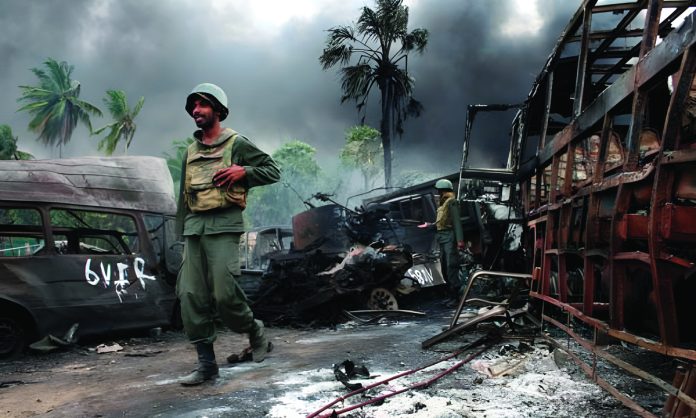Dr. Samreen Bari Aamir
Human nature drives people to seek peace and harmony, which is why states are often compared to mothers for their citizens, just as people feel safe and protected at home, they view their homes as secure havens. However, when a neighbor continuously disrupts peace and creates problems, a home can feel like a place of constant fear. If there is always a looming threat of attack, living safely becomes impossible. In such a situation, people may feel homeless despite still residing in their homes. India as a neighbor is one of the most barbaric and selfish, engaging in rivalries with almost all its neighbors. These conflicts have created and continue to fuel anarchic situations throughout the region, making India the worst neighbor for its surrounding countries.
Take the example of China, which is located on the northern side of India; its economy is five times larger than India’s, yet India’s ambitions to act and become the region’s policeman have compelled it to remain in conflict with China. India suffered a harsh defeat in the 1962 war over border disputes, as it had remained unsettled since its independence. It is also a fact that China and India share the longest unmarked border in the world. The violent encounters in the Ladakh region serve as another lesson, yet India refuses to learn; instead, it continues its attempts to undermine China’s prestige, territorial integrity, and global image.
Another dark side of India is its alleged role in protecting and promoting terrorism within the borders of its neighboring countries. Granting asylum to the Dalai lama is another major point of contention between India and China. A parallel Tibetan government operates from India with the support of the Indian government, posing a direct threat and challenge to China. This ongoing dispute exacerbates bilateral tensions, as China perceives India’s backing of the Dalai Lama and the Tibetan diaspora as unwarranted meddling in its domestic matters.
India has also historically interfered in Sri Lanka’s territorial matters and has provided aid and protection to militant groups, fueling insurgency in the region. No one can forget India’s support for Tamil militant groups, which was aimed at intervening in Sri Lanka’s internal affairs and exerting political pressure. Beyond this, India also seeks to dominate and disrupt Sri Lanka’s blue economy. The frequent arrests of Sri Lankan fishermen and violations of Sri Lanka’s maritime boundaries have become routine.
These poor fishermen remain constant targets of India’s hostility. India is also frustrated by Sri Lanka’s growing ties with China, particularly in projects like the Hambantota Port. As a result, it continues to pressure Sri Lanka, with its aggression often directed at vulnerable fishing communities. Historically, India has consistently exerted pressure on Sri Lanka to prevent it from fostering strong ties with China. Through various means, India has influenced Sri Lanka’s decision-making, particularly in discouraging or obstructing Chinese projects within the country. Furthermore, Sri Lanka has long been within India’s strategic sphere, with India leveraging its influence to shape both Sri Lanka’s domestic and foreign policies. The worst tragedy of Bangladesh is that it shares a 4,096 km-long border with India, which provides India with significant leverage to influence Bangladesh’s internal as well as external affairs. It is a well-established fact that India is the primary, if not the sole, actor in South Asia responsible for creating anarchy and instability. Nearly all of India’s neighboring countries are experiencing its hostility and facing direct aggression.
Pakistan has faced India’s hostility since its inception, as India never wholeheartedly recognized or accepted Pakistan’s sovereignty. Since independence, India’s primary objective has been to destabilize and divide Pakistan. Taking advantage of the political unrest in Bangladesh, India not only intervened in the internal affairs of then-East Pakistan but also provided arms, military support, and trained rebels, finally leading to the breakup of Pakistan through an armed insurgency.
In fact, after achieving its objective, India successfully turned Bangladesh into its political satellite, exerting direct influence over its internal and external matters. India has used the Awami League and its leaders, first Sheikh Mujibur Rahman and then his daughter, Sheikh Hasina Wajid, as a means of indirectly controlling Bangladesh. It is a well-established fact that India has manipulated Bangladeshi elections to ensure its preferred party remains in power. India’s ultimate goal is not only to control the people of Bangladesh but also to exploit its resources for its benefit.
Due to India’s advantageous geographic location, it has taken control of the major river networks, severely limiting Bangladesh’s access to water and making life more difficult for its citizens. Furthermore, India has significant control over trade and transportation networks, which limits Bangladesh’s independence in regional and global affairs. Beyond political and economic dominance, India’s Border Security Force (BSF) has frequently been occupied in fatal bombardments on unarmed Bangladeshi innocent civilians along the border, sparking allegations of human rights violations. Furthermore, India has actively discouraged deeper diplomatic and economic collaboration between Bangladesh and China, seeking to maintain Bangladesh within its exclusive orbit of influence.
No nation can understand and experience India’s antagonism better than Pakistan, which has borne the brunt of its aggressive posturing and cruel conduct since gaining independence. India’s refusal to fully acknowledge Pakistan’s sovereignty has had dire consequences, including the horrific massacres of displaced populations during Partition an atrocity unmatched in modern history. Shortly after independence, India seized Jammu and Kashmir, declaring unlawful control over the territory. Since then, Kashmiris have endured relentless persecution by Indian forces in their ongoing struggle for self-determination and liberation. India’s hostility escalated further when it launched an attack on Pakistan in 1965 and later played a destructive role in the separatist movement in East Pakistan (1971), leading to the creation of Bangladesh. India’s persistent interference in Pakistan’s internal affairs has fueled instability, making the region highly volatile.
India has been actively supporting separatist movements in Khyber Pakhtunkhwa, Balochistan, and Sindh, aiming to weaken Pakistan from within. Additionally, as the upper riparian state, India has repeatedly blocked Pakistan’s water supply, damaging crops and, at critical times, releasing excessive water without warning, causing devastating floods.India’s involvement in insurgency and terrorism is well-documented, with solid evidence such as the arrest of Kulbhushan Jadhav, an Indian intelligence agent caught operating in Balochistan. India has proven to be the most hostile neighbor for Pakistan, continuously working against Pakistan’s sovereignty and regional stability.
India’s greed for territorial expansion, aimed at gaining more power and exerting pressure on the innocent citizens of its neighboring countries, is increasing day by day. Its latest move to divide historically united, peacefully coexisting communities along the India-Myanmar border is ruthless. These communities, which share deep-rooted ethnic, religious, and cultural ties, are now at risk due to India’s aggressive policies. Despite the world community’s awareness, no state is willing to intervene, as global powers prioritize their economic interests in India. Even the United Nations has failed to take action.
Historically, in the 1970s, India and Myanmar signed the Free Movement Regime (FMR) agreement, allowing citizens from both countries to travel up to 16 km across the border without a visa for economic and family-related activities. This agreement served as a mutual acknowledgment of their long-standing historical ties. However, India’s hostile government is no longer respecting this crucial agreement and is actively undermining the peaceful coexistence of these communities. Furthermore, India’s attempts to annex border regions, including Nagaland, have been evident since its independence, reflecting its consistent policy of expansionism and regional dominance.
At the time of independence, the Naga region was densely populated by the Naga community, leading its leaders to declare sovereignty in 1947. However, India forcefully annexed the region, suppressing the Naga National Council’s demand for self-determination and independence. The Indian Army not only used brutal force to crush the movement but also employed a divide-and-rule strategy, creating internal discord among Naga leaders. As a result, the movement fragmented into multiple factions, weakening its strength. This deliberate approach ultimately enabled India to suppress the struggle for self-determination. The Sagging region in Myanmar has a significant Naga population, and its 1,643 km-long border with India serves as a clear example of how artificial borders have separated historically connected communities, severing long-standing ties and personal relationships. India’s pursuit of power and dominance has led to the division of families and the disruption of centuries-old bonds.
Although both governments initially agreed to keep the border open to facilitate free movement for these communities, India’s inconsistent policies and self-serving leadership have led to the unilateral decision to fence the entire boundary. This move has caused widespread unrest among local populations. Families are now being forcibly separated brothers on one side of the border in Myanmar and siblings on the Indian side threatening their cultural and historical unity. Such an authoritative approach by India has fueled resentment and growing tensions in the region.
Nepal, a smaller nation bordered by India to the north, finds itself in a challenging position due to India’s history of territorial conflicts and regional interference. Lasting peace has proven elusive for countries sharing boundaries with India, as demonstrated by the ongoing Kalapani-Lipulekh-Limpiyadhura dispute. Historical evidence from the 1815 Sugauli Treaty clearly establishes Nepal’s sovereignty over these territories, yet India continues its expansionist policies. This was evident when India unilaterally constructed a road through Lipulekh without consulting Nepal, prompting Kathmandu to respond by officially updating its national map to reaffirm its territorial claims.
India’s tendency to foster instability among its neighbors became apparent when it allegedly supplied weapons to Madhesi groups of Indian origin in Nepal, aiming to provoke unrest. This interference ultimately drove Nepal to seek closer relations with China, much to India’s dissatisfaction. Beyond political meddling, India has engaged in resource competition with Nepal by building dams on shared rivers. These projects not only disrupt Nepal’s water availability, affecting agricultural productivity, but also pose flood risks when India unexpectedly releases water, causing loss of life and damage to arable land. Despite Nepal’s persistent appeals, India has refused to establish fair water-sharing agreements. New Delhi continues to employ diplomatic coercion to influence Nepal’s domestic and foreign policies, infringing upon its sovereign rights. India’s role in supporting insurgent movements across South Asia reflects its broader strategy of territorial assertion and regional dominance. Such actions have consistently destabilized the area, positioning India as a primary obstacle to peace in the region.
The global community must oppose India’s misinformation and disinformation drives aimed at neighboring nations. By targeting smaller neighboring countries, India seems to use this influence as part of a larger geopolitical policy, possibly aligned with more powerful international actors. Time will ultimately expose the underlying motives behind these threatening policies.
The author is an Assistant Professor at DHA Suffa University and the Founding President of Center for Alternative Perspectives.










